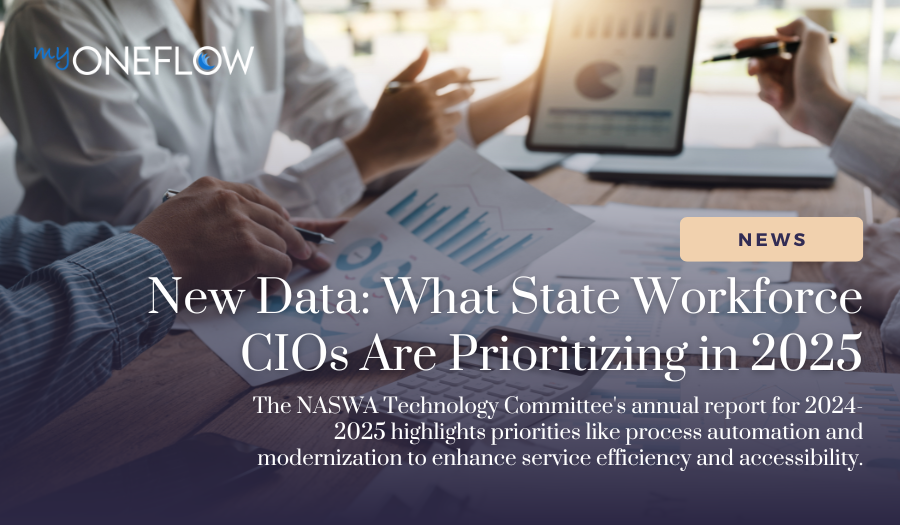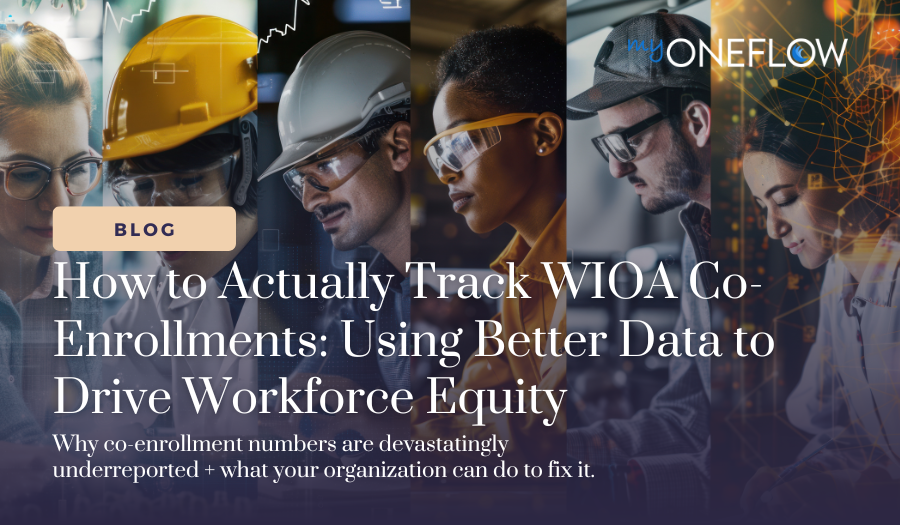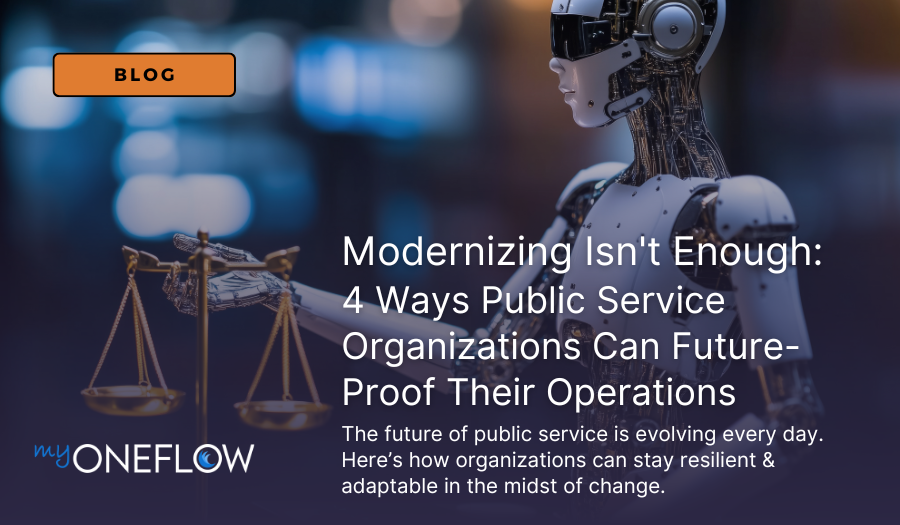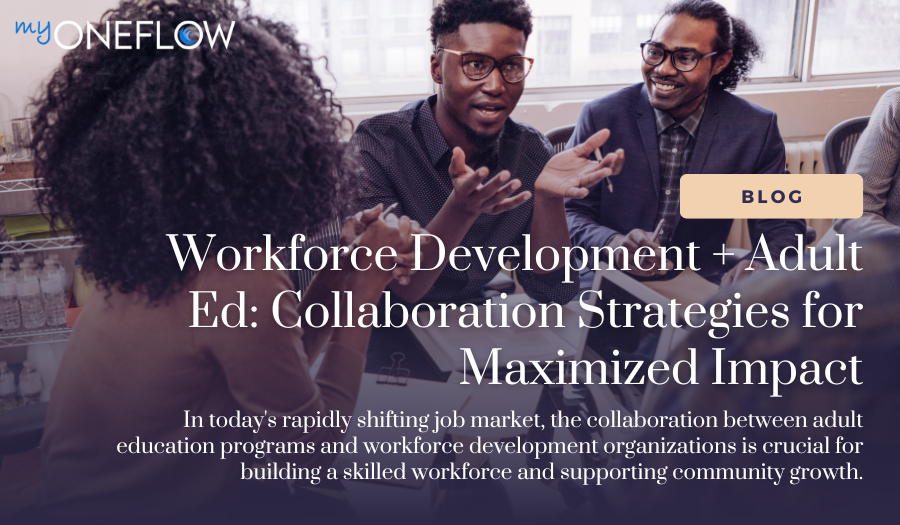How to Actually Track WIOA Co-Enrollments: Using Better Data to Drive Workforce Equity
The Workforce Innovation and Opportunity Act (WIOA) is rooted in a bold ambition: “to strengthen the United States workforce development system...
3 min read
myOneFlow Staff Jan 21, 2025 2:23:04 PM

State Workforce Agencies are at the forefront of supporting employment, training, and unemployment services across the United States. To address shifting demands and emerging challenges, the NASWA Technology Committee has released its annual report outlining the top priorities and initiatives for 2024-2025. Among the findings, a notable emphasis on process automation and modernization reflects the sector’s focus on creating more efficient and accessible systems for service delivery.
The National Association of State Workforce Agencies (NASWA) represents all 50 states, D.C., and U.S. territories, driving workforce innovation through collaboration, policy expertise, and shared best practices. By facilitating discussions and collecting insights from its member agencies, NASWA ensures that workforce programs stay prepared to meet the evolving needs of businesses and individuals. Reports like this one, authored by John Quichocho and Amy Hiltunen of the NASWA Technology Committee, are instrumental in guiding state IT strategies and supporting effective program delivery.
Securing state systems and safeguarding sensitive information remains the top priority for the second consecutive year. Workforce agencies are implementing stronger safeguards like advanced identity verification, risk management protocols, and insider threat mitigation to counter the rising tide of cyber risks.
Climbing to the #2 spot, AI is revolutionizing workforce services, with process automation emerging as a central theme. Agencies are increasingly leveraging AI to streamline operations, such as automating claim adjudications, streamlining eligibility verifications, and accelerating routine administrative tasks. These efforts not only reduce the workload on staff but also enable faster, more accurate responses for individuals accessing services. Process automation enhances efficiency across systems, helping agencies operate with greater precision while scaling services to meet demand.
Digital government initiatives are focused on creating seamless, accessible, and equitable online services. This includes incorporating responsive design, cross-agency collaboration, and tools like digital assistants to improve citizen experience. These efforts reflect a commitment to making services more inclusive, particularly for underserved populations.
A consistent finding in the NASWA report is the urgent need to modernize workforce and unemployment insurance systems. Many state agencies continue to operate using aging legacy systems that are difficult to maintain and unable to handle emerging demands. Modernization initiatives involve not only replacing antiquated infrastructure but also integrating automation-driven solutions. For example, transitioning from manual processes to automated workflows enables faster service delivery and significantly reduces errors. By prioritizing agile, incremental updates, states are ensuring their systems remain flexible, secure, and capable of incorporating new technologies.
CIOs also highlighted priorities such as improving accessibility, advancing data literacy, and fostering better communication through collaboration technologies. Accessibility measures focus on creating inclusive systems, ensuring all platforms and tools are usable by diverse populations. Data literacy programs empower both staff and service recipients to make smarter, data-informed decisions.
This latest report, developed by NASWA's Technology Committee, serves as a critical resource for understanding state agency needs and identifying forward-thinking solutions. By collecting comprehensive insights from CIOs across jurisdictions, the committee plays a pivotal role in shaping conversations about technology trends and best practices. The findings influence state-level strategies and guide national discussions about effective workforce program delivery.
The priorities outlined in the NASWA report reflect a clear direction toward addressing present-day challenges while capitalizing on the potential of emerging technologies like AI and process automation. Modernization of legacy systems remains at the heart of these efforts, serving as a foundation for building services that are efficient, scalable, and responsive to public needs. myOneFlow is the modern platform of choice for workforce leaders looking to upgrade their legacy systems and embrace process automation and enhanced digital collaboration. With portals for participants, staff, and employers, myOneFlow is a purpose-built solution for case management, reporting, referral management and more. Explore our package offerings to learn more.
1. What is NASWA, and how does it support workforce development?
The National Association of State Workforce Agencies (NASWA) represents workforce agencies across all 50 states, Washington D.C., and U.S. territories. NASWA supports workforce development by driving innovation through collaboration, sharing workforce technology best practices, and delivering policy expertise. Through initiatives like the NASWA Technology Committee’s reports, the organization helps workforce agencies tackle emerging challenges and enhance program efficiency.
2. What are the key technology priorities in the NASWA 2024-2025 report?
The NASWA Technology Committee’s 2024-2025 report identifies several key priorities for improving workforce systems, including:
Cybersecurity: Protecting sensitive workforce data with advanced safeguards against cyber threats.
Artificial Intelligence (AI) and Process Automation: Optimizing workforce services through AI-driven tools that streamline processes, boost accuracy, and reduce staff workloads.
Digital Government: Advancing digital workforce initiatives to deliver more accessible and equitable online services, especially for underserved communities.
3. Why is modernizing workforce systems a priority for state agencies?
Modernization of workforce and unemployment insurance systems is essential as many state agencies still depend on outdated legacy systems. These older systems struggle to meet modern demands, making upgrades crucial. System modernization ensures workforce tools are agile, secure, and capable of integrating technologies like process automation. This leads to improved scalability, faster service delivery, and better alignment with evolving workforce needs.

The Workforce Innovation and Opportunity Act (WIOA) is rooted in a bold ambition: “to strengthen the United States workforce development system...

Public service providers are navigating a turbulent environment shaped by shifting political priorities and funding directives. The current...

Effective workforce systems are rooted in collaboration. Under the Workforce Innovation and Opportunity Act (WIOA), workforce development agencies...